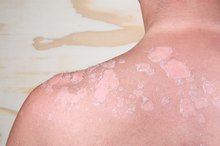What Causes a Purple or Discolored Nose?
We have all seen the purple, bulbous noses of W.C. Fields, Karl Malden and Bill Clinton. While the discoloration of a nose cannot be prevented, it can be treated. But it can be difficult to determine the cause of such a discoloration and thickening of the nose. In general, though, it is caused by a chronic condition called rosacea.
Rosacea
Usually when a nose appears bulbous and purple, it is the sign of the most extreme stage of a chronic condition called rosacea. This stage is called rhinophyma, and it is important to note that many cases do not progress to this stage. The first sign of the condition is facial reddening due to broken capillaries. This redness typically begins in the cheeks, nose, forehead or chin, usually around the time a person is 30 years old. As the problem continues, the redness may turn to bumps and pimples and spread to the eyelids, and finally to the nose, where the skin can become thickened and purple. There are four subtypes of rosacea, and the location of symptoms varies.
- Usually when a nose appears bulbous and purple, it is the sign of the most extreme stage of a chronic condition called rosacea.
- This stage is called rhinophyma, and it is important to note that many cases do not progress to this stage.
Symptoms and Signs
What Are the Causes of a Red Nose?
Learn More
While symptoms vary in degree and location, experts say they always include at least one of the following: persistent redness, a propensity to flush or blush easily, small red bumps or pimples and visible blood vessels. Other symptoms are raised red spots called plaques, thickening of the skin due to extra tissue, itchy and bloodshot eyes, rough, dry skin, itching and swelling of the face, and other areas of skin being affected, such as:
- the neck
- shoulders
Rosacea is not contagious, and there are no known causes, only hypotheses such as
- sun irritations
- skin bacteria
- blood flow
- abnormal inflammatory pathways
- psychological factors
It has not been scientifically proven to be hereditary, but some evidence suggests that it might be. Often people with the condition can recall a family member having the same condition. A common misconception about bulbous, purple or red noses is that they are the result of consuming large amounts of alcohol earlier in life. But the condition appears in both patients who do drink alcohol as well as those who do not. It is also proven that there is not an increased risk of cancer for patients with rosacea. However, it has been proven that drinking alcohol can compound the symptoms.
- While symptoms vary in degree and location, experts say they always include at least one of the following: persistent redness, a propensity to flush or blush easily, small red bumps or pimples and visible blood vessels.
- But the condition appears in both patients who do drink alcohol as well as those who do not.
Treatment
Since all patients' symptoms vary, treatment also varies for each patient. Physicians should treat each case differently based on the patient's specific symptoms. Usually, an initial antibiotic is prescribed, as well as topical cream to control the problem, with the ultimate goal being solely a topical treatment. Surgical procedures to remove visible blood cells with lasers or other light sources are more extreme measures of treatment. Though the cause for rosacea is unknown, there are treatments available that can reduce and slow the effects, as well as support groups to for people with the condition 2.
- Since all patients' symptoms vary, treatment also varies for each patient.
- Though the cause for rosacea is unknown, there are treatments available that can reduce and slow the effects, as well as support groups to for people with the condition 2.
Related Articles
References
- National Rosacea Society
- Rosacea Support Group
- Al-balbeesi AO, Almukhadeb EA, Halawani MR, Bin saif GA, Al mansouri SM. Manifestations of ocular rosacea in females with dark skin types. Saudi J Ophthalmol. 2019;33(2):135-141.doi:10.1016/j.sjopt.2019.01.006
- Gallo RL, Granstein RD, Kang S, et al. Standard classification and pathophysiology of rosacea: The 2017 update by the National Rosacea Society Expert Committee. J Am Acad Dermatol. 2018;78(1):148-155.doi:10.1016/j.jaad.2017.08.037
- Han J, Liu T, Zhang M, Wang A. The relationship between inflammatory bowel disease and rosacea over the lifespan: A meta-analysis. Clin Res Hepatol Gastroenterol. 2019;43(4):497-502.doi:10.1016/j.clinre.2018.09.009
Writer Bio
Kyle Anderson attended the University of Tennessee, where he received his B.S. and M.S. in English studies. He has worked as an editor and writer for several print publications and websites.









